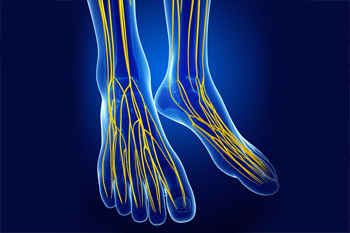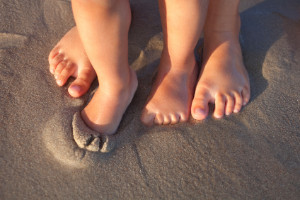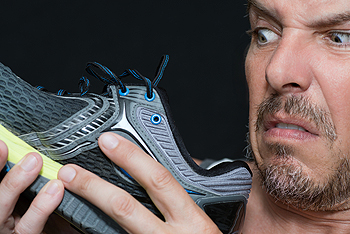Items filtered by date: December 2019
The Function of the Achilles Tendon
 The portion of tissue that connects the calf muscles to the heel is referred to as the Achilles tendon. This tendon makes it possible to walk, in addition to participating in running and jumping activities. If this should become inflamed as a result of an injury or damage that has happened gradually, it may develop into tendonitis. Symptoms of this condition can consist of pain and discomfort surrounding the heel. It can occur if the wrong shoes are worn during exercising, if a new sport is started, or if walking and running take place on an uneven surface. When this tendon is injured, it may be difficult to walk, and the pain may be intense upon arising in the morning. Relief may be found when the affected leg is elevated, and this may help to diminish a portion of the swelling. If you have endured an Achilles tendon injury, it is strongly suggested that you seek the advice of a podiatrist who can help you to manage this condition.
The portion of tissue that connects the calf muscles to the heel is referred to as the Achilles tendon. This tendon makes it possible to walk, in addition to participating in running and jumping activities. If this should become inflamed as a result of an injury or damage that has happened gradually, it may develop into tendonitis. Symptoms of this condition can consist of pain and discomfort surrounding the heel. It can occur if the wrong shoes are worn during exercising, if a new sport is started, or if walking and running take place on an uneven surface. When this tendon is injured, it may be difficult to walk, and the pain may be intense upon arising in the morning. Relief may be found when the affected leg is elevated, and this may help to diminish a portion of the swelling. If you have endured an Achilles tendon injury, it is strongly suggested that you seek the advice of a podiatrist who can help you to manage this condition.
Achilles tendon injuries need immediate attention to avoid future complications. If you have any concerns, contact Dr. Mark Gagnon of Advanced Podiatry. Our doctor can provide the care you need to keep you pain-free and on your feet.
What Is the Achilles Tendon?
The Achilles tendon is a tendon that connects the lower leg muscles and calf to the heel of the foot. It is the strongest tendon in the human body and is essential for making movement possible. Because this tendon is such an integral part of the body, any injuries to it can create immense difficulties and should immediately be presented to a doctor.
What Are the Symptoms of an Achilles Tendon Injury?
There are various types of injuries that can affect the Achilles tendon. The two most common injuries are Achilles tendinitis and ruptures of the tendon.
Achilles Tendinitis Symptoms
- Inflammation
- Dull to severe pain
- Increased blood flow to the tendon
- Thickening of the tendon
Rupture Symptoms
- Extreme pain and swelling in the foot
- Total immobility
Treatment and Prevention
Achilles tendon injuries are diagnosed by a thorough physical evaluation, which can include an MRI. Treatment involves rest, physical therapy, and in some cases, surgery. However, various preventative measures can be taken to avoid these injuries, such as:
- Thorough stretching of the tendon before and after exercise
- Strengthening exercises like calf raises, squats, leg curls, leg extensions, leg raises, lunges, and leg presses
If you have any questions please feel free to contact one of our offices located in Crestwood, Orland Park, and Summit, IL . We offer the newest diagnostic tools and technology to treat your foot and ankle needs.
How to Handle Poor Foot Circulation
 Those who are living with diabetes may be more likely to experience poor circulation in their feet. Poor circulation can lead to a number of foot complications including neuropathy and peripheral artery disease. There are, however, a few things you can do to better prevent poor circulation. Resisting smoking is a good way to reduce your likelihood of having poor circulation, since smoking makes arteries harden faster. Maintaining healthy blood pressure and cholesterol levels may also assist in reducing poor circulation. It is additionally recommended to practice an exercise routine, as exercise helps to stimulate blood flow. Because poor circulation can lead to more severe foot complications, it is recommended that you consult with a podiatrist for a proper diagnosis and advice on treatment options.
Those who are living with diabetes may be more likely to experience poor circulation in their feet. Poor circulation can lead to a number of foot complications including neuropathy and peripheral artery disease. There are, however, a few things you can do to better prevent poor circulation. Resisting smoking is a good way to reduce your likelihood of having poor circulation, since smoking makes arteries harden faster. Maintaining healthy blood pressure and cholesterol levels may also assist in reducing poor circulation. It is additionally recommended to practice an exercise routine, as exercise helps to stimulate blood flow. Because poor circulation can lead to more severe foot complications, it is recommended that you consult with a podiatrist for a proper diagnosis and advice on treatment options.
While poor circulation itself isn’t a condition; it is a symptom of another underlying health condition you may have. If you have any concerns with poor circulation in your feet contact Dr. Mark Gagnon of Advanced Podiatry. Our doctor will treat your foot and ankle needs.
Poor Circulation in the Feet
Peripheral artery disease (PAD) can potentially lead to poor circulation in the lower extremities. PAD is a condition that causes the blood vessels and arteries to narrow. In a linked condition called atherosclerosis, the arteries stiffen up due to a buildup of plaque in the arteries and blood vessels. These two conditions can cause a decrease in the amount of blood that flows to your extremities, therefore resulting in pain.
Symptoms
Some of the most common symptoms of poor circulation are:
- Numbness
- Tingling
- Throbbing or stinging pain in limbs
- Pain
- Muscle Cramps
Treatment for poor circulation often depends on the underlying condition that causes it. Methods for treatment may include insulin for diabetes, special exercise programs, surgery for varicose veins, or compression socks for swollen legs.
As always, see a podiatrist as he or she will assist in finding a regimen that suits you. A podiatrist can also prescribe you any needed medication.
If you have any questions, please feel free to contact one of our offices located in Crestwood, Orland Park, and Summit, IL . We offer the newest diagnostic and treatment technologies for all your foot care needs.
The Beginning Stages of Walking for Children
 Many children are born with flat feet. This is a result of flexible muscles and tendons that have not yet formed. As children learn to walk, the feet become stronger, and the arch generally develops during the teenage years. Research has shown the importance of babies walking barefoot while indoors. This will strengthen the toes as the foot grasps to the floor. When it is time to walk outdoors, your child will benefit from wearing shoes that are made of a soft, flexible material, and have ample room for the toes to move freely in. Your child’s feet will feel better when they are washed and dried thoroughly on a daily basis. Many children will walk on their toes as they are learning, and will gradually learn to walk correctly. If you notice your child is walking with their toes turned out, or isn’t walking by eighteen months, it is suggested that you consult with a podiatrist.
Many children are born with flat feet. This is a result of flexible muscles and tendons that have not yet formed. As children learn to walk, the feet become stronger, and the arch generally develops during the teenage years. Research has shown the importance of babies walking barefoot while indoors. This will strengthen the toes as the foot grasps to the floor. When it is time to walk outdoors, your child will benefit from wearing shoes that are made of a soft, flexible material, and have ample room for the toes to move freely in. Your child’s feet will feel better when they are washed and dried thoroughly on a daily basis. Many children will walk on their toes as they are learning, and will gradually learn to walk correctly. If you notice your child is walking with their toes turned out, or isn’t walking by eighteen months, it is suggested that you consult with a podiatrist.
Making sure that your children maintain good foot health is very important as they grow. If you have any questions, contact Dr. Mark Gagnon of Advanced Podiatry. Our doctor can provide the care you need to keep you pain-free and on your feet.
Keeping Children's Feet Healthy
Having healthy feet during childhood can help prevent medical problems later in life, namely in the back and legs. As children grow, their feet require different types of care. Here are some things to consider...
Although babies do not walk yet, it is still very important to take care of their feet.
Avoid putting tight shoes or socks on his or her feet.
Allow the baby to stretch and kick his or her feet to feel comfortable.
As a toddler, kids are now on the move and begin to develop differently. At this age, toddlers are getting a feel for walking, so don’t be alarmed if your toddler is unsteady or ‘walks funny’.
As your child gets older, it is important to teach them how to take care of their feet.
Show them proper hygiene to prevent infections such as fungus.
Be watchful for any pain or injury.
Have all injuries checked by a doctor as soon as possible.
Comfortable, protective shoes should always be worn, especially at play.
If you have any questions please feel free to contact one of our offices located in Crestwood, Orland Park, and Summit, IL . We offer the newest diagnostic and treatment technologies for all your foot and ankle needs.
Bacteria and Sweaty Feet
 When the feet sweat continuously, it may be a condition that is known as plantar hyperhidrosis. Sweaty feet can be uncomfortable and may lead to bacterial and fungal infections. It is beneficial to wear socks and shoes that are made from a breathable material, which may help to control any odor that can come from the feet. Research has indicated that walking barefoot as often as possible may help to manage this condition, in addition to refraining from wearing the same pair of shoes for two days in a row. Some patients find it helpful to use an antiperspirant on their feet, as well as wear insoles that can absorb the sweat. If you are suffering from this condition, it is strongly suggested that you consult with a podiatrist who can help you to control plantar hyperhidrosis.
When the feet sweat continuously, it may be a condition that is known as plantar hyperhidrosis. Sweaty feet can be uncomfortable and may lead to bacterial and fungal infections. It is beneficial to wear socks and shoes that are made from a breathable material, which may help to control any odor that can come from the feet. Research has indicated that walking barefoot as often as possible may help to manage this condition, in addition to refraining from wearing the same pair of shoes for two days in a row. Some patients find it helpful to use an antiperspirant on their feet, as well as wear insoles that can absorb the sweat. If you are suffering from this condition, it is strongly suggested that you consult with a podiatrist who can help you to control plantar hyperhidrosis.
If you are suffering from hyperhidrosis contact Dr. Mark Gagnon of Advanced Podiatry. Our doctor can provide the care you need to attend to all of your foot and ankle needs.
Hyperhidrosis of the Feet
Hyperhidrosis is a rare disorder that can cause people to have excessive sweating of their feet. This can usually occur all on its own without rigorous activity involved. People who suffer from hyperhidrosis may also experience sweaty palms.
Although it is said that sweating is a healthy process meant to cool down the body temperature and to maintain a proper internal temperature, hyperhidrosis may prove to be a huge hindrance on a person’s everyday life.
Plantar hyperhidrosis is considered to be the main form of hyperhidrosis. Secondary hyperhidrosis can refer to sweating that occurs in areas other than the feet or hands and armpits. Often this may be a sign of it being related to another medical condition such as menopause, hyperthyroidism and even Parkinson’s disease.
In order to alleviate this condition, it is important to see your doctor so that they may prescribe the necessary medications so that you can begin to live a normal life again. If this is left untreated, it is said that it will persist throughout an individual’s life.
A last resort approach would be surgery, but it is best to speak with your doctor to find out what may be the best treatment for you.
If you have any questions please feel free to contact one of our offices located in Crestwood, Orland Park, and Summit, IL . We offer the newest diagnostic and treatment technologies for all your foot and ankle needs.

